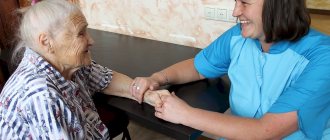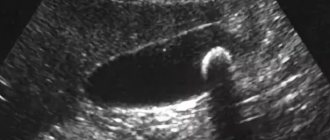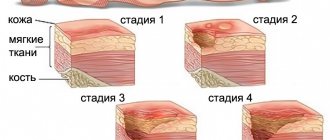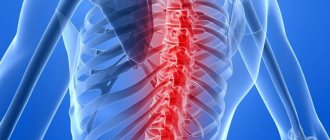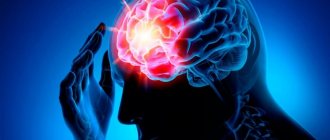13.11.2014
Maltseva Marina Arnoldovna
Head of the consultation department - neurologist, specialist in the field of extrapyramidal pathologies, doctor of the highest category
A stroke is a very complex condition that has many negative consequences for the patient’s body, significantly reduces the quality of his life, and actually completely “turns off” some important functions, for example, the ability to understand the speech of others, memory problems, etc.
However, people who have had one stroke are at serious risk of having another. Today, unfortunately, this is not uncommon. Most often, a recurrent stroke occurs unexpectedly, affecting other parts of the brain. If a person has not yet fully recovered from the first stroke, the rehabilitation period after the second will be even more difficult and slower, since the area of damage to the brain has increased.
Causes of recurrent stroke
Experts note that in approximately half of the cases, a recurrent stroke occurs due to the fact that a person ceases to consider himself sick, as a result of which he ceases to follow the recommendations of doctors. The patient, gradually returning to his normal life, stops following:
- your blood pressure;
- the condition of blood vessels;
- the condition of the heart muscle;
This is why doctors say the main reason for a recurrent stroke is neglect of one’s health.
Why is it so important to monitor all of the above indicators?
- Pressure. If for the first stroke only a sharp jump in pressure will be dangerous, then for a second stroke even a slight increase in pressure will be enough.
- Vessels. Here it is very important to carefully examine all the vessels of the brain and check for the presence of aneurysms that can “rupture”, which will lead to hemorrhage in the brain. If aneurysms are found, they must be removed immediately. No less dangerous to the health of a patient who has suffered a stroke are atherosclerotic plaques, which significantly impede the blood supply to the brain.
- Heart. It is important for the patient to undergo an ECG and exclude the possibility of blood clots. For prevention, doctors may advise the patient to take courses of blood thinning medications.
People who have suffered a stroke need to constantly monitor their blood pressure, blood cholesterol levels, and also follow the principles of a healthy diet.
Miser pays twice
A similar examination is worth undergoing for those who have suffered a hypertensive crisis, a sudden attack of angina pectoris (pain in the heart area), or arrhythmias. These conditions can also be classified as stroke precursors - transient ischemic attacks. What the vast majority of patients do not know about. Most clinic doctors do not correlate these conditions with the threat of acute cerebrovascular accident.
The same cannot be said about far-sighted foreigners. Recently, Professor Shirokov visited the center of cardiovascular diseases in the Japanese city of Osaka. What he saw aroused professional envy in him: in the Land of the Rising Sun they pay much more attention to stroke prevention than here, identifying those who have experienced transient ischemic attacks as a risk group. They are prescribed all the studies mentioned above, which in Japan are part of the mandatory medical examination.
In our country they are not included in the standard of care. It turns out to be a paradoxical situation, Shirokov believes. Instead of preventing the first attack of a stroke, we only come to our senses when a brain catastrophe has already occurred, causing irreversible changes, or even death, of individual areas of the brain.
And the costs that go into treating existing strokes and preventing secondary strokes are not comparable to those needed to prevent this deadly disease. But there is no point in waiting for our state to shake things up and reconsider the standards of medical care. You need to arrange a technical inspection for yourself - the same as many of us do for our cars, sparing no time or money.
Signs of a recurrent stroke
Doctors note that the risk of a recurrent stroke is highest in the first year of recovery. The occurrence of a recurrent stroke can be determined by characteristic signs:
- by deterioration of vision (in some cases: blindness in one eye);
- by numbness of the limbs (in the worst case: paralysis of the limbs or half of the body);
- for digestive problems;
- by loss of consciousness;
- for impaired coordination of movements;
- for speech impairment.
By the way
The brain suffers from lack of nutrition more often than other organs. Its needs for oxygen and nutrients are very high. Constituting only 5–6% of body weight, it consumes more than 20% of all the blood that the heart pumps.
The brain is very sensitive to a lack of oxygen - it only takes two minutes for irreversible changes in neurons to occur when a large artery is blocked. Therefore, it is necessary to prevent cerebrovascular accidents as early as possible. The supply to the brain remains reliable only as long as the heart is fully functioning, and the vessels are elastic and able to expand, increasing the blood flow necessary for the functioning of the central nervous system.
Consequences of a recurrent stroke
In 70% of cases, the consequences of a second stroke are much more severe than the initial one: most cases end in the death of the patient. The patient may permanently lose, for example, some intellectual abilities or mobility.
Also, the consequences of a repeated stroke include severe, irreversible changes in a large area of brain tissue.
Doctors remind that after the first stroke the patient needs to completely change his lifestyle. From now on, a person will have to constantly monitor his health, constantly record changes, adhere to a special diet and do therapeutic exercises. This should become a habit, because to minimize the risk of a recurrent stroke, at least 4-5 years of prevention are necessary.
Clinical Brain Institute Rating: 3/5 — 6 votes
Share article on social networks
Problem #1
For angioneurologists, preventing recurrent stroke has always been problem No. 1. Among the causes that lead to disability and death, recurrent stroke ranks high. If after the first stroke the patient lives on average about 8–9 years, then after the second acute cerebrovascular accident, the life span allotted to him is reduced to ... 2–3 years.
Experts have no doubt that without proper prevention and treatment, a vascular accident can recur. It is enough to refer to the same statistics, according to which, if a patient has suffered one stroke, then within a year with a probability close to 15% he will suffer a second one, and after a few years this probability approaches 30–40%.
“After a stroke, the body retains the mechanisms that led the patient to this development of events: a tendency to intravascular thrombus formation, atherosclerotic changes in the arteries,” explains Professor Shirokov. – In addition, those who have suffered an acute cerebrovascular accident often have other diseases, such as severe diabetes, hypertension, heart failure, and arrhythmia. In this case, the reserves for preventing a recurrent vascular accident in patients are small. Especially if concomitant diseases are in advanced form.
Programs:
Assessment of rehabilitation potential
Movement restoration
Rehabilitation after stroke
Restoration of cognitive functions
Early (resuscitation) rehabilitation
First aid
When the first symptoms of a stroke appear:
- Place the patient on the bed.
- Call an ambulance.
- Place the patient on his back or side if vomiting begins or he loses consciousness.
- Unfasten clothes and belt.
- Open the window to allow fresh air into the room.
- Place a cold wet towel or ice in a bag wrapped in cotton cloth on your head.
- Measure the patient’s blood pressure, pulse, and monitor blood pressure and breathing until the doctors arrive.
- If necessary, give medications that were previously prescribed by the attending physician.
- Constantly talk to the patient, try to get answers to questions from him, and do not lose contact.
Prognosis in older people
In patients with ischemic stroke, age is one of the most important factors that influence the prognosis and quality of life after the acute period of the disease. In older people, ischemic stroke is much more severe than in younger patients. Doctors at the Yusupov Hospital take an individual approach to the treatment of elderly patients; when prescribing medications, they use doses recommended for a certain age. When using innovative methods of kinesitherapy, the age characteristics of the body are taken into account.
The prognosis after an ischemic stroke suffered by an elderly person is influenced by the following factors:
- localization of the ischemic focus;
- prevalence of cerebral infarction zone;
- a disease that caused a stroke;
- severity of neurological symptoms.
Coma caused by cerebral edema is the most severe neurological manifestation of a stroke, sharply worsening the prognosis.
Factors that positively influence the results of rehabilitation of elderly patients and improve the prognosis are:
- a small lesion confirmed by computed tomography;
- maintaining the patient's full consciousness;
- minimal number of neurological damages;
- absence of pronounced atherosclerotic changes in blood vessels according to the results of Dopplerography of the arteries of the head and neck;
- the patient's profession requiring constant mental stress;
- normal blood pressure;
- absence of arrhythmias and other heart diseases.
Diet and other recovery methods
Advertising:
Dietary nutrition is aimed at normalizing cholesterol levels and preventing the progression of atherosclerosis. The amount of meat, eggs, and animal fat should be reduced; it is allowed to eat fish, lean veal, and poultry. Additionally, you can take Omega-3, which stabilizes cholesterol and blood pressure. In the absence of hypertension, natural coffee will also be useful, but no more than 2 cups per day. You need to eat more often:
- apples;
- pears;
- bran;
- greenery;
- other plant foods.
Exercise, even passive exercise, is important to prevent bedsores and helps fight paralysis. To eliminate stress, many patients are advised to take antidepressants and work with a psychologist. It is recommended to visit special resorts, sanatoriums, and water treatments.
How long do they live after pathology?
The least life-threatening is the so-called micro-stroke - during it, the patient’s blood supply in the basin of a small cerebral artery is disrupted, which can be restored on its own. In acute ischemic stroke, oxygen starvation occurs in a larger area of the left or right hemisphere, therefore, the consequences will be more serious. The most severe is a hemorrhagic stroke - in it, blood permeates the brain matter with the appearance of a hematoma.
Stroke has become “younger” - it often occurs in people aged 35-45 years.
The prognosis for survival after a stroke is highly dependent on the age of the patient and the severity of the pathology. Up to 45 years of age, mortality does not exceed 25%; most patients die due to extensive cerebral hemorrhages due to trauma and rupture of aneurysms. After 50 years of age, mortality exceeds 40-45%; in women, the disease often ends in failure. After 70-80 years, only 20% of people survive, but full recovery is impossible, the consequences are as follows:
Advertising:
- paralysis;
- change in mental abilities;
- worsening of chronic diseases;
- recurrent stroke.
After an attack, many live 10 years or more; at a young age, with quality treatment, life expectancy is common among their peers. But negative prognoses are also not uncommon - in 30% of survivors, death occurs in the first year after the initial attack. After repeated attacks, the average life expectancy is usually no more than 2-4 years, this is due to the persistence of risk factors - a tendency to develop blood clots, atherosclerosis, hypertension.
Epilepsy is a dangerous disease that is accompanied by severe seizures and loss of consciousness. You can manage its symptoms at home, but sometimes hospital treatment is necessary. Read more in the article: “treatment of epilepsy at home.”
Treatment
A patient with a recurrent stroke most often ends up in the intensive care unit. At the Yusupov Hospital, doctors begin treatment and early rehabilitation immediately after diagnosis. The prognosis is most favorable when patients are admitted to the neurology clinic within the first 4 hours from the appearance of the first signs of acute cerebral circulation. Doctors at the neurology clinic prescribe adequate treatment, thanks to which the nerve cells around the ischemic site completely restore functional activity.
The use of thrombolysis therapy by neurologists at the Yusupov Hospital for elderly patients significantly improves the prognosis. As a thromolytic agent, doctors at the neurology clinic use the most effective drug - tissue plasminogen activator. After the clot dissolves, blood flow through the affected vessels is restored, the supply of oxygen and nutrients to the ischemic area and the area around the cerebral infarction improves. The outcome of ischemic stroke is improved by the use of ancrod (an enzyme from snake venom) in the first 3 hours after the development of acute cerebrovascular accident and for five subsequent days.
To prevent further formation of blood clots and re-embolism, elderly people are given:
- direct anticoagulants (sodium heparin or low molecular weight heparin);
- antiplatelet agents;
- drug from the thienopyridine group Ticlopidine.
If there are contraindications or a high risk of complications from taking these drugs, doctors at the Yusupov Hospital prescribe Clopidogrel to patients. Drugs with neuroprotective and neurometabolic effects improve the plasticity of nerve cells. The tone of cerebral arteries in elderly people increases under the influence of vasoactive drugs.
In elderly people, ischemic stroke often occurs against the background of severe arterial hypertension. During the 7-10 days of the acute period of stroke, cardiologists at the Yusupov Hospital when the patient’s systolic blood pressure is less than 200 mm. rt. Art. do not carry out antihypertensive therapy, since hypotension worsens the oxygen saturation of brain areas susceptible to ischemia. In patients with systolic blood pressure above 200 mm. rt. Art. it is reduced very slowly to numbers of 10 mm. rt. Art. exceeding the pressure to which the patient is adapted. After the acute period, cardiologists select individual antihypertensive therapy.
Rehabilitation
Early rehabilitation significantly improves the prognosis after a stroke. Doctors at the Yusupov Hospital begin to carry out rehabilitation measures from the first day the patient is admitted to the neurology clinic. The intensity of the rehabilitation program depends on the patient’s condition and the degree of his disability. At the Yusupov Hospital, the department for seriously ill patients is equipped with special multifunctional beds. Using the devices of a multifunctional bed, medical personnel can periodically change the patient’s position, carry out hygiene procedures, and care for the patient. Changing your posture helps avoid the formation of bedsores and congestion. To reduce the risk of developing contractures, joint pain, pneumonia, and deep vein thrombosis at the Yusupov Hospital, specialists carry out passive rehabilitation from the first days of treatment.
To improve the prognosis of older people, rehabilitation specialists at the Yusupov Hospital after a stroke use the following innovative methods for restoring impaired functions:
- PNF;
- Voita therapy;
- minor manual therapy;
- Castillo-Morales method;
- kinesio taping;
- Mulligan concept;
- Bobath therapy.
What influences the consequences of the disease?
Complications are most serious in elderly patients. There are many reasons, besides natural wear and tear of tissues and organs:
- hypertension that responds poorly to treatment;
- the presence of arrhythmia and coronary heart disease;
- high cholesterol;
- chronic kidney diseases, etc.
That is why in people over 60-70 years of age, a stroke often ends in coma and death, the disease progresses aggressively, affects brain tissue faster and covers large areas. At a young age, the ability to recover is higher, but a number of factors worsen the prognosis:
Advertising:
- hypertension;
- diabetes;
- obesity;
- vascular and heart diseases;
- prolonged stress;
- pregnancy;
- taking hormonal contraceptives.
With extensive hemorrhage or ischemia, the cells suffer so much that even after a year they cannot recover. Due to improper functioning of the brain, there is a predisposition to a repeated attack. The larger the affected area, the higher the risk of paralysis, mental disorders, and edema. Paralysis and immobile position of the body also aggravate the consequences - bedsores, kidney and lung diseases, and infections occur.
Abdominal pain occurs no less often in adults than in children. There are many reasons for this phenomenon, some of them quite serious. Colic and its treatment Colic is understood as an acute, sharp pain in the abdomen or side, which occurs in the form of spasms. Read more in the article: “stomach colic in adults.”

